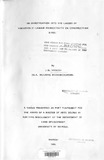| dc.description.abstract | This study set out to investigate the major causes of variation in labor productivity on construction sites in Kenya. Labor productivity is one measure of the efficiency with which the human labor is assessed. Any variations in labor productivity will affect the construction project.
A decline in productivity causes an increase in the time necessary to complete the project and the total cost of the project.
It has been established from literature that technical and human factors are among the factors that cause variation in labor productivity. These factors are within the control of the management of the construction firm. This is the main assumption of the study. The study investigated the extent to which the technical and human factors predominate. Linear multiple regression analysis was used, in which the labor productivity was the dependent variable and the technical and human factors on the site the independent variables.
The study has established that human factors are more important determinants of labor productivity than technical factors. This was found to be true for both the activities of walling and concreting that were studied from a number of sites under investigation. The most important human factors in the study were related to financial benefits which show the importance the construction laborer attaches to his wages. Other factors such as machinery and equipment did not show much variation because they tend to be the same in most sites. The study concluded that labor productivity in sites investigated can be improved through monetary based productivity improvement schemes, such as incentive payment.
The study is organized in five chapters. Chapter one introduces the problem and its setting, states the objectives of the study and the assumptions of the study. Chapter two of the study forms the literature review. The concept of productivity and productivity measurement are discussed. The technical and the human factors that affect labor productivity are reviewed. The same chapter makes references as to the relevance of these factors to the construction industry and the construction site.
Chapter three outlines the management organization of a construction site. The main aspects of the management that directly affect labor and its performance are discussed in relation to the case study.
In the fourth chapter, it is outlined how the data was collected and analyzed. The analysis showed the factors that affect labor productivity and the degree of their effect.
The last chapter draws the overall conclusions and recommendations of the study. In this chapter the implication of the final models is discussed in details and recommendations given. Bibliography and appendices appear at the end of the study while footnotes appear at the end of each chapter. | en |

